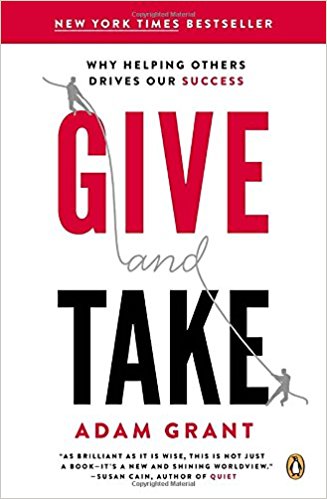Give and Take Summary
5 min read ⌚

Why Helping Others Drives Our Success
In this world, there are a few types of people: givers, takers, and those in between.
In our summary of Adam Grant’s “Give and Take” we will cover the definitions of givers, takers, and matchers, and we will show you how you can recognize them.
We will also conclude which one is best suited for success.
So read on and find out your type.
Who Should Read “Give and Take”? and Why?
You may have the urge to underestimate “Give and Take,” but that would be a mistake.
If we decided to explain this book’s premise shortly, we would conclude that it is good to be nice to people, it is better to give than take, et cetera.
However, that is not all there is to Grant’s book.
He does not only present his theory – but he also backs it up with empirical data. If you look more deeply into the information he gives you, you will end up having a superior way to conduct business and climb the success ladder.
We recommend “Give and Take” to managers, leaders and all readers that want to make the world a better place.
About Adam Grant
 Adam Grant is the Wharton School’s highest-rated professor and the youngest tenured faculty member. He is a former advertising director and a junior Olympian.
Adam Grant is the Wharton School’s highest-rated professor and the youngest tenured faculty member. He is a former advertising director and a junior Olympian.
“Give and Take Summary”
Every time you step out of the door and interact with someone else, you decide the type of person you will be.
There are two options: you can be a giver, a taker, or a matcher.
What do these categories mean?
A giver is someone who always puts the interests of others first, and does what is best for them. Takers take care of their interests and let others take care of themselves. Matchers can be both, or, in other words, treat others as they treat them.
What do you think, who will most likely end up at the bottom of the ladder to success?
It is the givers.
However, the givers occupy the highest levels of the ladder as well. Hence, they fill the top and the bottom, with the middle full of matchers and takers.
Giving matches the core values of many cultures and religions. Furthermore, its importance grows as the economy transforms.
Just think back a few generations. Then, people worked mostly independently, no matter the industry they were in. Nowadays, on the other hand, people increasingly collaborate and work in teams.
When it comes to working in teams, giving works better. Giving is also more suited for service businesses, a sector which is currently in expansion.
The networks that givers, takers, and matchers develop are different in their core.
Takers network actively. They can be charming, but care to use their charm only on more important or influential people. As they climb the organizational hierarchy, they start to mistreat their subordinates. They present themselves as better than others, by sharing only the information that serves their good image. As you can notice, their networks are mostly artificial and are bound to decay over time. This is the case because people lose their patience with constant takers.
Matchers (as you can suppose by their name) try to match their behavior with that of people in their environment. In the beginning, they treat takers well, but after takers betray them, they get ready for punishment. Matchers create networks based on fairness and reciprocity.
We have nothing against reciprocity, but when you deploy it as a way of functioning in your network, it has drawbacks.
For instance, if you give to someone who functions mainly of reciprocity, that person will assume that the gifts come along with some request.
Matchers concentrate on the immediate benefits attached to all transactions.
Key Lessons from “Give and Take”
1. Giving Through Teaching
2. How Givers and Takers Communicate
3. Give and Survive
Giving Through Teaching
Teaching shows the genuine power of giving.
Great performers or athletes are not born “great.” They do not demonstrate the best potential or the highest intelligence from the get-go in their lives.
Many develop after they get coaching from a giving educator who inspires and motivates them.
Furthermore, giving managers observe the potential outcomes in their employees. At the point when givers hire people, they can commit errors as promptly as takers. They can pick the wrong prospects and be tricked by appearances.
Takers tend to stick to their decisions because admitting a bad choice makes them look inadequate.
Givers, on the other hand, value the workers they picked, yet move them to different positions or let them go if that is what’s best for the organization.
How Givers and Takers Communicate
You can impact others using dominance or prestige. When you establish dominance, other individuals consider you to be powerful and authoritative. On the off chance that you earn prestige, you become influential since people admire you.
These two alternatives spring from your style of correspondence.
Takers pick strength and dominance. They stand up for themselves and underline pride and achievements.
However, when you gain dominance, other people lose it.
Give and Survive
Being a giver, and using the qualities of giving, does not guarantee you success.
In fact, you can wind up depleted with little or nothing to show for everything you have done.
So, be a giver, but do not let takers exploit you. It is understandable that you wish to see others make it. However, you should not put others’ interests in front of your own.
You have to keep a certain level of self-interest.
Successful givers show balanced behavior. At the same time they act based on their need to see others prosper, balanced with reaching their own goals.
Some givers make a mistake and become other-centered to an unhealthy degree. They give up without a limit and become involved in pathological altruism.
Givers are in danger of burnout.
Exhausted givers notice both physical and emotional problems. However, taking a break is not the “medicine” that will revitalize them. They need more giving, in the right context. In other words, the best medicine is the realization that their actions are significant.
“Give and Take” Quotes
As Samuel Johnson purportedly wrote, “The true measure of a man is how he treats someone who can do him absolutely no good. Share on X The more I help out, the more successful I become. But I measure success in what it has done for the people around me. That is the real accolade. Share on X Success doesn’t measure a human being, effort does. Share on X Being a giver is not good for a 100-yard dash, but it’s valuable in a marathon. Share on X If we create networks with the sole intention of getting something, we won’t succeed. We can’t pursue the benefits of networks; the benefits ensue from investments in meaningful activities and relationships. Share on XOur Critical Review
The only thing we have to say regarding “Give and Take” is that it is not only interesting: it is also useful in all kinds of situations.
Emir is the Head of Marketing at 12min. In his spare time, he loves to meditate and play soccer.







